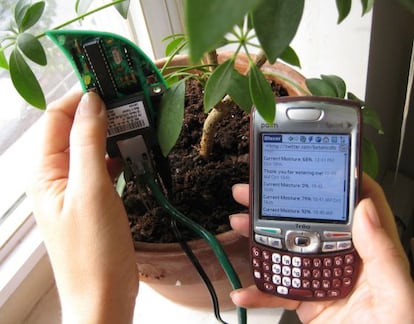The plants that tweet when they're thirsty
Several projects are working to bring online intelligence to simple shrubs

The last few tweets were desperate cries for water. "Water me please! Urgent." This message, sent from Toronto, Canada, was posted again and again on the Twitter account of @pothos with increasing urgency. But in the cold world of data communication, none of pothos's 3,969 followers came to help, and one day, all of a sudden, the tweets stopped coming. This story isn't quite as dramatic as it might sound, given that pothos is a plant which, thanks to an artificial intelligence platform called Botanicalls, has acquired capabilities that are normally associated with humans, such as chatting, sending tweets, answering questions and making phone calls.
The creation of this system marks a notable advance in relationships between man and plant life, as is reflected by the acquisition of a plant with Botanicalls technology by the Museum of Modern Art (MoMA) in New York for its permanent collection. The plant, which will be shown in the design section, is a work that has been in development since 2006. Its creators, Rob Faludi, Kate Hartman and Kati London, specialize in interactive projects that create new relationships between people and objects.
Its basic functionality, which lets domestic plants request water from their owners, has been converted into a DIY kit by SparkFun electronics. Anyone with an electrical outlet and an internet connection will be able to convert their favorite shrub into an avid Twitter user.
Not all of the famous names in the world of communicating plants are based in the United States. There are also a few in Spain, and some live in Barcelona. Mister Melvin Green is a fern that speaks English, and was created by Ra¨²l Mart¨ª, Mariona Arau and Elisabet Espelt, founders of the Barcelona-based technical translation company, Treeloc. "We wanted to carry out an advertising campaign with a difference," explains Mart¨ª, who shares a desk with Mr Green. "We wanted it to transmit our desire and our ability to translate any language, even that of plants.
The creation of this system marks a notable advance in relationships between man and plant life
"Melvin is connected to a series of sensors, which measure and translate everything that is around it, from meteorological variables to other conditions: light, ambient temperature and humidity levels," Mart¨ª explains. "From that data, a series of algorithms defines four moods - happiness, sadness, anger and sleepyness - which are then used by an artificial intelligence engine that responds to a human user via tweets."
Mr Green - which, like any other user of the social networks, is more or less active from day to day - can be found on Twitter at @MrMelvinGreen. If users are looking for a response from Mr Green they can use the hashtag #translatingmelvin, and if they are really lucky they can chat with him live at www.translatingmelvin.com.
One of the most active of these intelligent projects is Welovegarden, a plant from Welovecode, a studio created by two young creative minds from Asturias, Rom¨¢n Torre and Pelayo M¨¦ndez. They have come up with a number of different artistic productions, which have all been focused on interactivity, such as the scenery for Babylon, the latest opera from the Barcelona company La Fura dels Baus, which premiered in Munich in October.
The plant programmed by Welovecode uses tables of phrases made up of three elements, which are created in response to its physical state. "Our plant comes out with very positive and optimistic conversations if it has been watered, and if it has a lot of light and a good temperature," explains Rom¨¢n Torre. "If, however, it is left without water or in the dark, its sentences are more and more sad, negative and nervous." Its creators are currently working to give the plant its perfect partner. "The idea is to develop a small garden full of plants that are capable of communicating with one another, or to create a number of plants that are located in different countries, and that constantly give each other information about their surroundings," explains Rom¨¢n.
Tu suscripci¨®n se est¨¢ usando en otro dispositivo
?Quieres a?adir otro usuario a tu suscripci¨®n?
Si contin¨²as leyendo en este dispositivo, no se podr¨¢ leer en el otro.
FlechaTu suscripci¨®n se est¨¢ usando en otro dispositivo y solo puedes acceder a EL PA?S desde un dispositivo a la vez.
Si quieres compartir tu cuenta, cambia tu suscripci¨®n a la modalidad Premium, as¨ª podr¨¢s a?adir otro usuario. Cada uno acceder¨¢ con su propia cuenta de email, lo que os permitir¨¢ personalizar vuestra experiencia en EL PA?S.
?Tienes una suscripci¨®n de empresa? Accede aqu¨ª para contratar m¨¢s cuentas.
En el caso de no saber qui¨¦n est¨¢ usando tu cuenta, te recomendamos cambiar tu contrase?a aqu¨ª.
Si decides continuar compartiendo tu cuenta, este mensaje se mostrar¨¢ en tu dispositivo y en el de la otra persona que est¨¢ usando tu cuenta de forma indefinida, afectando a tu experiencia de lectura. Puedes consultar aqu¨ª los t¨¦rminos y condiciones de la suscripci¨®n digital.








































